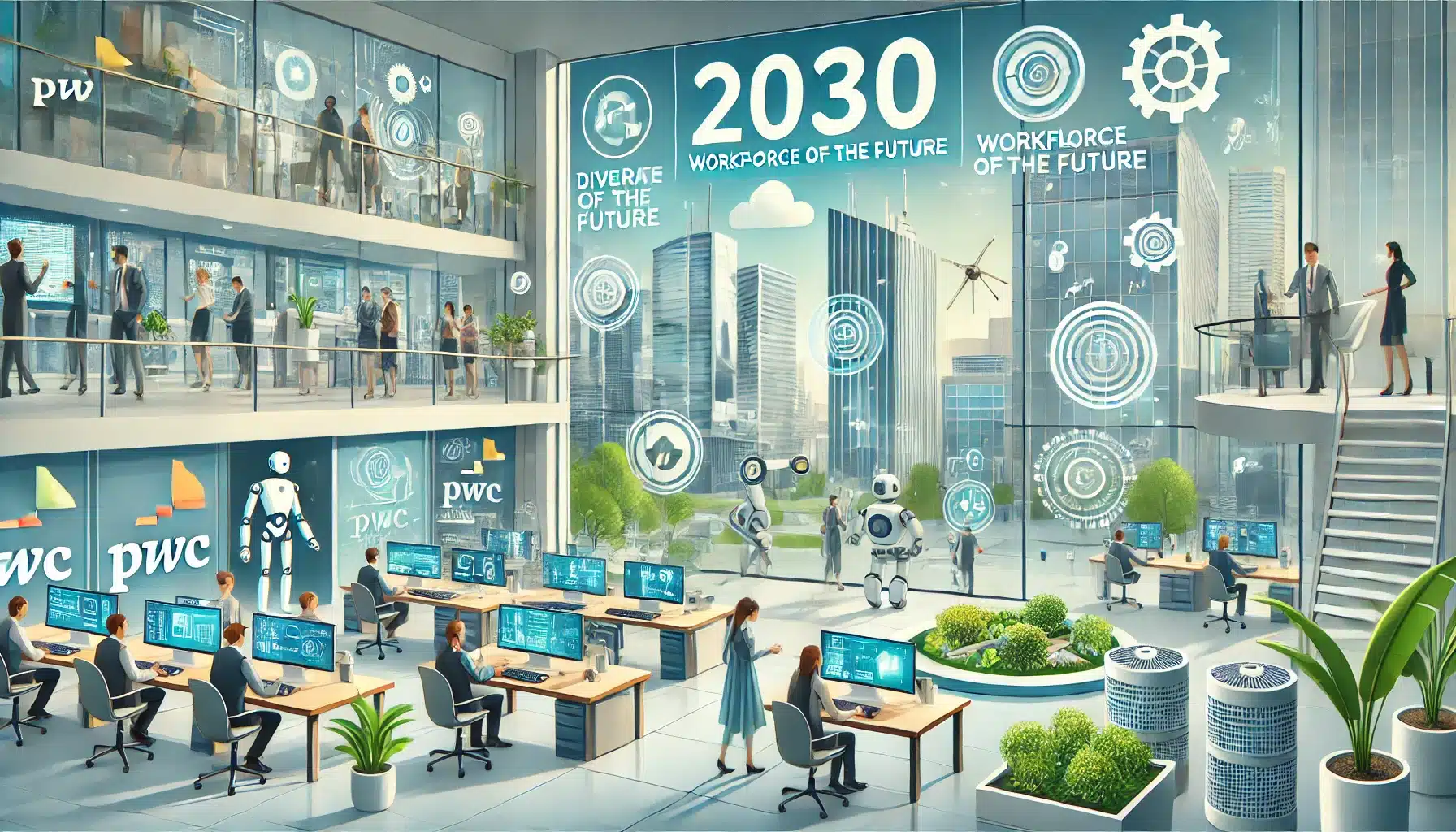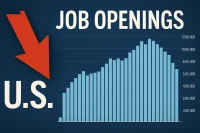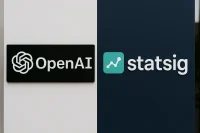The way people work is undergoing a seismic shift, with technology and workers’ demands making employers think more and more about their staff.
According to PwC’s report, “Workforce of the Future: The Competing Forces Shaping 2030,” technology, sustainability, and social change will reshape careers, companies, and even the idea of employment itself.
The report highlights four possible futures, each showing how businesses, workers, and governments could respond to these changes.
Four Possible Futures for Work
In the Red World, innovation comes first. Fast-moving startups thrive by constantly launching new products and ideas.
Creativity and agility matter more than stability, and workers become independent freelancers, always chasing the next project.
Traditional jobs with long-term security are rare, and personal branding becomes essential to staying employed.
The Blue World tells a different story.
Here, corporate power dominates.
Large multinational companies run the economy, offering stable jobs—but only to those with top-tier skills.
Workers inside these corporations follow clear career paths, with strong employer investment in their training.
However, automation and artificial intelligence mean many lower-skilled jobs disappear entirely.
In the Green World, purpose and ethics guide decision-making.
Companies are judged not just by profits, but by their social and environmental impact.
Workers actively seek employers whose values match their own, especially around sustainability.
As green technology expands, new jobs emerge in fields like renewable energy, environmental consulting, and social impact.
Finally, the Yellow World envisions workers taking control themselves.
Cooperatives, worker-owned businesses, and community enterprises flourish.
Technology becomes a shared resource rather than a competitive advantage, helping people collaborate, learn new skills, and build careers outside traditional corporate structures. Flexibility and community purpose matter more than paychecks or promotions.

What’s Driving These Changes?
According to PwC, four major forces will shape which version of the future becomes reality.
Technology is the biggest, with automation, AI, and digital platforms redefining how people find work, develop skills, and interact with employers.
Workers will need to embrace lifelong learning and digital fluency to stay relevant.
Demographic shifts will also play a major role.
Populations are ageing in much of the developed world, shrinking the available workforce. At the same time, migration will increase, creating a global talent race.
Younger generations will bring different expectations to work, valuing purpose, ethical leadership, and flexibility.
Climate change and resource scarcity add another layer of complexity.
Companies will face growing pressure to cut emissions, reduce waste, and contribute to environmental sustainability. This shift will create new jobs in green industries while eliminating roles tied to fossil fuels and unsustainable practices.
Finally, global economic and political power is shifting. Emerging economies in Asia and beyond will become essential sources of both talent and innovation.
Meanwhile, political uncertainty, trade conflicts, and changing regulations could disrupt traditional talent flows and supply chains.
How Businesses Can Prepare
For employers, the message from PwC is clear: preparing for a single future isn’t enough.
Companies must build workforces that are adaptable in any scenario.
This means developing employees with broad, future-proof skills like critical thinking, creativity, and cultural agility. Companies also need to create inclusive workplaces that attract diverse talent and foster innovation.
Responsible use of technology will be essential.
As AI and automation advance, companies need to ensure these tools enhance human work rather than simply replacing workers. At the same time, aligning workforce strategies with sustainability goals will become a competitive advantage, not just a moral decision.
Hiring? Post jobs for free with WhatJobs
What Workers Need to Do
For workers, adaptability will be the key to long-term success.
The days of training for one career and staying in it for life are over. Instead, lifelong learning will be essential. Workers will also need to build strong personal brands and develop skills that make them valuable across industries.
Choosing the right employer could also become more important than ever.
In a world where corporate values matter, workers will seek out companies whose ethics and purpose align with their own.
In some cases, workers may even bypass traditional employment altogether, opting instead to join worker-owned collectives or run their own businesses.
Need Career Advice? Get employment skills advice at all levels of your career
Preparing for an Uncertain Future
The workforce of 2030 isn’t set in stone.
The choices businesses, governments, and workers make today will determine which version of the future becomes reality.
Whether corporate power grows stronger, workers take back control, or sustainability drives every decision, one thing is certain—the future belongs to those who are ready to adapt.
FAQs
How will work change in 2030?
By 2030, work is expected to be more flexible, technology-driven, and skills-focused. Remote and hybrid working will likely be standard across many industries, with companies prioritising results over hours spent at a desk. Automation and artificial intelligence will continue to reshape roles, particularly in sectors like manufacturing, finance, and customer service. This shift means employees will need to adapt, focusing on developing skills that complement technology rather than compete with it.
Traditional career paths may become less common, replaced by more project-based or freelance work, allowing people to work for multiple employers simultaneously. Lifelong learning will also become essential, with workers expected to regularly upskill to keep pace with evolving technology and industry demands.
Diversity and inclusion are likely to be higher on the agenda, with businesses recognising the benefits of a more representative workforce. Sustainability will also influence work, with companies adopting greener policies and placing greater value on environmental and social impact.
While technology will create efficiencies, it could also increase challenges around work-life balance, mental health, and job security. Overall, work in 2030 will be more digital, more fluid, and shaped by global trends such as climate change, demographics, and shifting economic power.
What jobs will be replaced by 2030?
By 2030, many jobs involving repetitive tasks, data processing, and predictable physical work are expected to be replaced or heavily automated. Roles such as data entry clerks, telemarketers, cashiers, and assembly line workers will likely decline as artificial intelligence, robotics, and self-service technology become more advanced and widespread. In sectors like transportation, self-driving vehicles could significantly reduce the need for drivers, particularly in logistics and delivery services.
Administrative jobs, including scheduling assistants and payroll clerks, could also shrink as software handles these tasks faster and more accurately. In retail, automation will impact stock management, checkouts, and inventory tracking, reducing demand for human workers. Even some entry-level roles in legal, finance, and healthcare could be affected, with AI reviewing contracts, processing claims, or analysing medical images.
However, while technology will replace some roles, it will also create demand for new jobs focused on maintaining, programming, and improving these technologies. Jobs requiring creativity, emotional intelligence, and complex problem-solving—such as in healthcare, education, and technology development—are likely to be safer. Overall, 2030 will see a shift in demand, with fewer jobs focused on routine tasks and more emphasis on uniquely human skills that machines struggle to replicate.
How many jobs could be automated by 2030?
Estimates suggest that by 2030, around 375 million workers globally—roughly 14% of the global workforce—could need to switch jobs due to automation. In terms of tasks, studies indicate that up to 30% of current work activities across industries could be automated by the end of the decade. This doesn’t mean 30% of all jobs will disappear entirely, but rather that a significant portion of tasks within jobs will be automated, leading to shifts in the way people work.
Jobs that involve predictable, routine tasks are at the highest risk. This includes roles in manufacturing, retail, administration, and customer service. Advances in artificial intelligence, machine learning, and robotics are driving this change, allowing machines to handle tasks like data entry, transaction processing, and even some customer interactions.
However, automation will also create new roles, particularly in areas like technology development, system maintenance, and data analysis. The net impact will depend on how quickly businesses adopt these technologies and how effectively workers reskill to meet changing demands. While automation will reduce some jobs, it will also transform others, meaning the real challenge will be adapting to new ways of working rather than a simple loss of employment.




